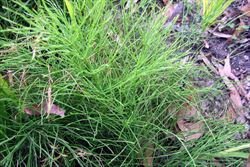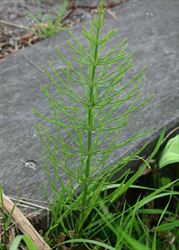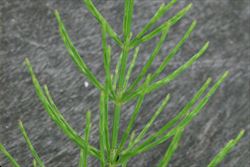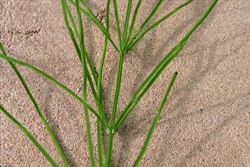Click on images to enlarge

infestation (Photo: Trevor James)

habit (Photo: Trevor James)

habit (Photo: Mellisa Offord)

young vegetative stems (Photo: Sheldon Navie)

vegetative stem (Photo: Trevor James)

close-up of older stem with whorled branches (Photo: Trevor James)

close-up of younger stem with developing branches (Photo: Trevor James)

close-up of four-angled branches (Photo: Mellisa Offord)

habit with fertile stems (Photo: Trevor James)

scouringrush horsetail (Equisetum hyemale) has branchless vegetative stems (Photo: Sheldon Navie)

dwarf horsetail (Equisetum scirpoides) is much smaller plant with branchless stems (Photo: Sheldon Navie)
Scientific Name
Equisetum arvense L.
Family
Equisetaceae
Common Names
bottle brush, bottlebrush, bull pipes, common horsetail, corn horsetail, field horsetail, foxtail, foxtail rush, foxtail-rush, horse pipes, horsetail, horsetail fern, joint grass, joint weed, mare's tail, meadow pine, meadowpine, paddock-pipes, pine grass, pine-grass, rush, scouring rush, shave grass, shavegrass, snake grass, snake-grass, western horsetail
Origin
This species originated a very long time ago and is considered to be native to most of the temperate regions of the Northern Hemisphere. More specifically, it is native to North America (i.e. Canada and USA), most of Europe and large parts of Asia (i.e. Cyprus, Iran, Iraq, Lebanon, Turkey, Armenia, Azerbaijan, Georgia, Russia, Kazakhstan, Kyrgyzstan, Tajikistan, Turkmenistan, Uzbekistan, Bhutan, northern India, Nepal, Mongolia, China, Japan and Korea).
Cultivation
This species has been cultivated as an ornamental in gardens, particularly in the temperate regions of Australia.
Naturalised Distribution
Common horsetail (Equisetum arvense ) is not yet widely naturalised in Australia. It has been recorded from some parts of central New South Wales (i.e. in the Sydney and Moonan districts). It has also been collected from gardens in Tasmania, Victoria and Queensland.
Habitat
Common horsetail (Equisetum arvense) prefers cooler and wetter climates in the temperate regions of Australia. It is a potential weed of open woodlands, grasslands, pastures, crops, roadsides, gardens, swamps, wetlands, waterways and the margins of other waterbodies.
Habit
An upright (i.e. erect) and long-lived (i.e. perennial) plant usually growing 5-60 cm tall. Its aboveground parts are short-lived (i.e. annual) and re-grow each year from creeping underground stems (i.e. rhizomes) that can be up to several metres long.
Distinguishing Features
- a mostly upright and long-lived plant re-growing each year from creeping underground stems.
- it produces two distinctly different types of stems, without obvious leaves, and does not have any true flowers.
- its green "vegetative" stems are tall, thin, and produce several spreading branches at each of their joints.
- its whitish or pale brown "fertile" stems are shorter, thicker, and topped with a cone-like reproductive structure.
- this reproductive structure (1-4 cm long) is greenish to brownish in colour and consists of numerous scale-like structures.
Stems and Leaves
The stems are mostly upright (i.e. erect or ascending) but can sometimes trail along the ground at first before turning upwards (i.e. occasionally decumbent). These stems are conspicuously jointed and are of two distinct types. Most of the stems are "vegetative" (i.e. sterile). These are green in colour (5-60 cm tall and 1.5-5 mm thick) with small cup-shaped sheaths at their joints (i.e. nodes). They are hollow, grooved lengthwise (i.e. longitudinally), and produce groups (i.e. whorls) of thin branches (8-15 cm long and about 5 mm thick) that are sometimes mistaken for leaves. These branches are four-angled and usually emanate from each of the stem joints (i.e. nodes). The sheaths are actually the reduced, scale-like, leaves. They are green to dark-brown in colour, borne in clusters (i.e. whorls) of 6-18, and are fused together to form a small cylindrical or cup-shaped structure (5-8 mm long) topped with teeth that are 2-3 mm long.
The second type of stem is whitish or pale brown in colour, shorter and somewhat thicker (up to 30 cm tall and 8 mm thick). These are known as "fertile" stems and bear reproductive structures at their tips. They are jointed and sheathed like the vegetative stems but lack the whorls of green branches.
Flowers and Fruit
Being closely related to the ferns, this plant does not produce true flowers or seeds. Instead it produces spores in a cone-like structure known as a strobilus. These structures (i.e. strobili) are borne at the tips of the 'fertile' stems and usually appear during early spring, before the 'vegetative' (i.e. sterile) stems. They are greenish, whitish or brownish in colour (1-4 cm long) with numerous stalked scale-like structures (i.e. sporangiophores) which bear the spores. The masses of minute spores are pale greenish to yellow in colour.
Reproduction and Dispersal
This plant reproduces vegetatively via long creeping underground stems (i.e. rhizomes) and rounded tubers, and also by large numbers of tiny spores.
The creeping underground stems (i.e. rhizomes) and tubers enable colonies to spread laterally over time. They can also be dispersed longer distances by cultivation, soil disturbance or in dumped garden waste. The tiny spores are dispersed by wind and water.
Environmental Impact
Common horsetail (Equisetum arvense) is regarded as an environmental weed in New South Wales and as a potential environmental weed in the ACT, Victoria, South Australia, Western Australia and Tasmania. Though this species in not yet widely established in Australia, it has the potential to become a persistent weed of riparian areas, wetlands and other low-lying areas in the temperate regions of Australia that have an annual rainfall above 500 mm. When it becomes established in gardens and bushland areas it spreads quickly by creeping underground stems (i.e. rhizomes) and is difficult to eradicate.
The only known occurrences of this species escaping cultivation and spreading into bushland in Australia have been in the Sydney and Moonan districts in New South Wales. Populations of common horsetail (Equisetum arvense) were reported to be infesting hundreds of square metres along creeklines at these sites.
Other Impacts
This species is also toxic to livestock and is a weed of crops, orchards and pastures overseas. Horses, cattle and sheep are particularly susceptible to common horsetail (Equisetum arvense) poisoning, and animals that eat contaminated hay are also at risk. It is very difficult to control in crops, and yields can be reduced through direct competition as well as inhibitory substances that affect the growth of neighbouring crop plants.
Legislation
This species is declared under legislation in the following states and territories:
- ACT: C1 - notifiable pest plant (a pest plant whose presence must be notified), and C4 - prohibited pest plant (a pest plant whose propagation and supply is prohibited). This declaration also applies to all horsetails (Equisetum spp.).
- New South Wales: Class 1 - a state prohibited weed. The presence of the weed on land must be notified to the local control authority and the weed must be fully and continuously suppressed and destroyed (throughout the entire state). This declaration also applies to all horsetails (Equisetum spp.).
- Northern Territory: C - not to be introduced into the Territory. This declaration also applies to all horsetails (Equisetum spp.).
- Queensland: Class 1 - introduction into the state is prohibited, and landowners must take reasonable steps to keep land free of this species (throughout the entire state). It is also illegal to sell a declared plant or its seed in this state. This declaration also applies to all horsetails (Equisetum spp.).
- South Australia: 1@ - this species is a prohibited terrestrial plant. Its presence must be notified and the plant must be destroyed (throughout the entire state). This declaration also applies to all horsetails (Equisetum spp.).
- Tasmania: D - the importation or sale of this species is prohibited and measures to reduce its population in an area, eradicate it from an area, or restrict it to a particular area may be required. This declaration also applies to all horsetails (Equisetum spp.).
- Victoria: S - prohibited and is to be eradicated from the state if possible. This declaration also applies to all horsetails (Equisetum spp.).
- Western Australia: P1 - trade, sale or movement into the state prevented, and P2 - to be eradicated (throughout the entire state). This declaration also applies to all horsetails (Equisetum spp.).
Management
For information on the management of this species see the following resources:
- the Victorian Department of Primary Industries Pest Plant Note on this species, which is available online at http://www.dpi.vic.gov.au.
Similar Species
Common horsetail (Equisetum arvense) is a very distinctive plant, however there are other species of horsetails (Equisetum spp.) that are similar. Most of these are not yet present in this country, but at least five other species (i.e. Equisetum hyemale, Equisetum palustre, Equisetum scirpoides, Equisetum bogatensis and Equisetum ramosissimum) have also become naturalised or have been grown here as garden plants (i.e. ornamentals).
Common horsetail (Equisetum arvense) may also be confused with young she-oak trees (i.e. Casuarina spp. and Allocasuarina spp.). These native trees also have small green, jointed, branches that resemble leaves. However, these are not borne in whorls like those of common horsetail (Equisetum arvense). The she-oaks (Casuarina spp. and Allocasuarina spp.) also grow into much larger trees and eventually produce distinctive woody fruit.

